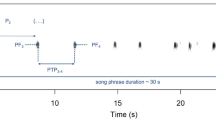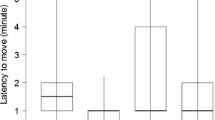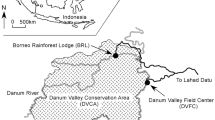Abstract
Neighbour-stranger discrimination plays a crucial role in territorial animals and is expressed as either the dear enemy phenomenon or the nasty neighbour effect. Previous evidence showed that the size of intruding groups affected the expression of neighbour-stranger discrimination. However, few studies have compared neighbour-stranger discrimination between individual-level and group-level intrusions in conspecifics. In this study, we used playback experiments to investigate whether the western black crested gibbon (Nomascus concolor) discriminates intruding neighbours from strangers via vocal signal and explore the effect of intruder type (individual versus group) on neighbour-stranger discrimination. We found that the focal gibbons responded more intensively to neighbours versus strange intruders with shorter movement delay time and longer counter-singing duration. Furthermore, the intruder type had a pronounced influence on subjects’ response intensity. The focal gibbons reacted with faster movement velocity and shorter locomotor duration to individual intruders than to group intruders. Our results provide the first empirical evidence for the nasty neighbour effect in Hylobatidae. These results also suggest that group intruders are not necessarily more threatening than individual intruders, and that the perceived threat posed by intruders is affected by ecological factors and social contexts.
Significance statement
Neighbour-stranger discrimination (NSD) is widespread in territorial animals. However, few studies have compared the differences in NSD between individual-level and group-level intrusions in conspecifics. We studied the effect of intruder type (individual versus group) on NSD dynamics using acoustic playback experiments in free-ranging western black crested gibbons (Nomascus concolor). We provide the first experimental evidence for the nasty neighbour effect in Hylobatidae. Our findings support the threat level hypothesis and suggest that the threat level of the intruder depends on ecological factors and social contexts. We also suggest that group intruders do not necessarily have a higher threat level than individual intruders, at least among the western black crested gibbons.



Similar content being viewed by others
Data availability
All data generated or analysed during this study are included in this manuscript (and its supplementary information files).
References
Andrieu J, Penny SG, Bouchet H, Malaivijitnond S, Reichard UH, Zuberbühler K (2020) White-handed gibbons discriminate context-specific song compositions. PeerJ 8:e9477. https://doi.org/10.7717/peerj.9477
Baayen RH (2008) Analyzing linguistic data: a practical introduction to statistics using R. Cambridge University Press, Cambridge
Bartlett TQ (2007) The Hylobatidae: small apes of Asia. In: Campbell CJ, Fuentes A, Mackinnon KC, Panger M, Bearder S (eds) Primates in perspective. Oxford University Press, New York, pp 274–289
Briefer E, Rybak F, Aubin T (2008) When to be a dear enemy: flexible acoustic relationships of neighbouring skylarks, Alauda arvensis. Anim Behav 76:1319–1325. https://doi.org/10.1016/j.anbehav.2008.06.017
Brockelman WY (2009) Ecology and the social system of gibbons. In: Whittaker D, Lappan S (eds) The gibbons: new perspectives on small ape socioecology and population biology. Springer New York, New York, pp 211–239
Brown JL, Orians GH (1970) Spacing patterns in mobile animals. Annu Rev Ecol Syst 1:239–262. https://doi.org/10.1146/annurev.es.01.110170.001323
Cant MA, Otali E, Mwanguhya F (2002) Fighting and mating between groups in a cooperatively breeding mammal, the banded mongoose. Ethology 108:541–555. https://doi.org/10.1046/j.1439-0310.2002.00795.x
Christensen C, Radford AN (2018) Dear enemies or nasty neighbors? Causes and consequences of variation in the responses of group-living species to territorial intrusions. Behav Ecol 29:1004–1013. https://doi.org/10.1093/beheco/ary010
Cowlishaw G (1992) Song function in gibbons. Behaviour 121:131–153. https://doi.org/10.1163/156853992x00471
Crofoot MC, Gilby IC (2012) Cheating monkeys undermine group strength in enemy territory. P Natl Acad Sci USA 109:501–505. https://doi.org/10.1073/pnas.1115937109
Decellieres M, Zuberbühler K, León J (2021) Habitat-dependent intergroup hostility in Diana monkeys, Cercopithecus diana. Anim Behav 178:95–104. https://doi.org/10.1016/j.anbehav.2021.06.001
Fan P-F, Jiang X-L (2008) Effects of food and topography on ranging behavior of black crested gibbon (Nomascus concolor jingdongensis) in Wuliang Mountain, Yunnan, China. Am J Primatol 70:871–878. https://doi.org/10.1002/ajp.20577
Fan P-F, Jiang X-L (2010) Maintenance of multifemale social organization in a group of Nomascus concolor at Wuliang Mountain, Yunnan, China. Int J Primatol 31:1–13. https://doi.org/10.1007/s10764-009-9375-9
Fan P-F, Jiang X-L, Liu C-M, Luo W-S (2006) Polygynous mating system and behavioural reason of black crested gibbon (Nomascus concolor jingdongensis) at Dazhaizi, Mt. Wuliang, Yunnan. China Zool Res 27:216–220
Fan P, Liu C, Luo W, Jiang X (2007) Can a group elicit duets from its neighbours? A field study on the black-crested gibbon (Nomascus concolor jingdongensis) in central Yunnan, China. Folia Primatol 78:186–195. https://doi.org/10.1159/000099139
Fan P-F, Jiang X-L, Tian C-C (2009a) The critically endangered black crested gibbon Nomascus concolor on Wuliang Mountain, Yunnan, China: the role of forest types in the species’ conservation. Oryx 43:203–208. https://doi.org/10.1017/S0030605308001907
Fan P-F, Xiao W, Huo S, Jiang X-L (2009b) Singing behavior and singing functions of black-crested gibbons (Nomascus concolor jingdongensis) at Mt. Wuliang, central Yunnan. China Am J Primatol 71:539–547. https://doi.org/10.1002/ajp.20686
Fan P-F, Jiang X-L, Liu C-M, Luo W-S (2010) Sonogram structure and timing of duets of western black crested gibbon in Wuliang Mountain. Zool Res 31:293–302. https://doi.org/10.3724/SP.J.1141.2010.03293
Fan P-F, Xiao W, Feng J-J, Scott MB (2011) Population differences and acoustic stability in male songs of wild western black crested gibbons (Nomascus concolor) in Mt. Wuliang. Yunnan Folia Primatol 82:83–93. https://doi.org/10.1159/000329128
Fan P-F, Bartlett T-Q, Fei H-L, Ma C-Y, Zhang W (2015) Understanding stable bi-female grouping in gibbons: feeding competition and reproductive success. Front Zool 12:5. https://doi.org/10.1186/s12983-015-0098-9
Fisher JB (1954) Evolution and bird sociality. In: Huxley J, Hardy AC, Ford EB (eds) Evolution as a process. Allen & Unwin, London, pp 71–83
Furrer RD, Kyabulima S, Willems EP, Cant MA, Manser MB (2011) Location and group size influence decisions in simulated intergroup encounters in banded mongooses. Behav Ecol 22:493–500. https://doi.org/10.1093/beheco/arr010
Geissmann T (2002) Duet-splitting and the evolution of gibbon songs. Biol Rev 77:57–76. https://doi.org/10.1017/S1464793101005826
Getty T (1989) Are dear enemies in a war of attrition. Anim Behav 37:337–339. https://doi.org/10.1016/0003-3472(89)90125-5
Gittins SP (1980) Territorial behavior in the agile gibbon. Int J Primatol 1:381–399. https://doi.org/10.1007/bf02692281
Guan Z-H, Huang B, Ning W-H, Ni Q-Y, Jiang X-L (2013a) Proximity association in polygynous western black crested gibbons (Nomascus concolor jingdongensis): network structure and seasonality. Zool Res 34:E1-8. https://doi.org/10.3724/SP.J.1141.2013.E01E01
Guan Z-H, Huang B, Ning W-H, Ni Q-Y, Sun G-Z, Jiang X-L (2013b) Significance of grooming behavior in two polygynous groups of western black crested gibbons: implications for understanding social relationships among immigrant and resident group members. Am J Primatol 75:1165–1173. https://doi.org/10.1002/ajp.22178
Guan Z-H, Ma C-Y, Fei H-L, Huang B, Ning W-H, Ni Q-Y, Jiang X-L, Fan P-F (2018) Ecology and social system of northern gibbons living in cold seasonal forests. Zool Res 39:255–265. https://doi.org/10.24272/j.issn.2095-8137.2018.045
Guan Z-H (2013) The ecological and social behavior of black-crested gibbon(Nomascus concolor)at Dazhaizi, Wuliang Mountain, central Yunnan, China. PhD thesis, Kunming Institute of Zoology, Chinese Academy of Sciences. University of Chinese Academy of Sciences, Kunming
Ham S, Hedwig D, Lappan S, Choe JC (2016) Song functions in nonduetting gibbons: evidence from playback experiments on Javan gibbons (Hylobates moloch). Int J Primatol 37:225–240. https://doi.org/10.1007/s10764-016-9897-x
Herbinger I, Papworth S, Boesch C, Zuberbühler K (2009) Vocal, gestural and locomotor responses of wild chimpanzees to familiar and unfamiliar intruders: a playback study. Anim Behav 78:1389–1396. https://doi.org/10.1016/j.anbehav.2009.09.010
Huang B (2011) The ecological and behavioural adaption of black-crested gibbon (Nomascus concolor) to the habitat at Dazhaizi, Wuliang Mountain, central Yunnan, China. PhD thesis, Kunming Institute of Zoology, Chinese Academy of Sciences. University of Chinese Academy of Sciences, Kunming
Hu N, Guan Z, Huang B, Ning W, He K, Fan P, Jiang X (2018) Dispersal and female philopatry in a long-term, stable, polygynous gibbon population: evidence from 16 years field observation and genetics. Am J Primatol 80:e22922. https://doi.org/10.1002/ajp.22922
Huang B, Guan Z, Ni Q, Orkin JD, Fan P, Jiang X (2013) Observation of intra-group and extra-group copulation and reproductive characters in free ranging groups of western black crested gibbon (Nomascus concolor jingdongensis). Integr Zool 8:427–440. https://doi.org/10.1111/1749-4877.12020
Jaeger RG (1981) Dear enemy recognition and the costs of aggression between salamanders. Am Nat 117:962–974. https://doi.org/10.1086/283780
Jiang X, Wang Y (1997) The singing ecology and behavior of black-crested gibbons. Acta Anthropol Sinica 16:294–300. https://doi.org/10.16359/j.cnki.cn11-1963/q.1997.04.006
Jiang X, Ma S, Wang Y, Sheeran LK, Wang Q (1994) The mating system of black-crested gibbon (Hylobates concolor) and its relationships with ecology, behaviour and phylogeny. Acta Anthropol Sinica 13:344–352
Jiang X, Wang Y, Wang Q (1999) Coexistence of monogamy and polygyny in black-crested gibbon (Hylobates concolor). Primates 40:607–611. https://doi.org/10.1007/bf02574835
Jiang X, Luo Z, Zhao S, Li R, Liu C (2006) Status and distribution pattern of black crested gibbon (Nomascus concolor jingdongensis) in Wuliang Mountains, Yunnan, China: implication for conservation. Primates 47:264–271. https://doi.org/10.1007/s10329-005-0175-3
Kim S, Lappan S, Choe JC (2011) Diet and ranging behavior of the endangered Javan gibbon (Hylobates moloch) in a submontane tropical rainforest. Am J Primatol 73:270–280. https://doi.org/10.1002/ajp.20893
Lemoine S, Boesch C, Preis A, Samuni L, Crockford C, Wittig RM (2020) Group dominance increases territory size and reduces neighbour pressure in wild chimpanzees. R Soc Open Sci 7:200577. https://doi.org/10.1098/rsos.200577
Ma H, Ma C, Fei H, Yang L, Fan P (2020) Cao vit gibbons (Nomascus nasutus) sing at higher elevation but not in peripheral areas of their home range in a karst forest. Int J Primatol 41:701–713. https://doi.org/10.1007/s10764-020-00178-z
Markham AC, Alberts SC, Altmann J (2012) Intergroup conflict: ecological predictors of winning and consequences of defeat in a wild primate population. Anim Behav 84:399–403. https://doi.org/10.1016/j.anbehav.2012.05.009
McComb K, Packer C, Pusey A (1994) Roaring and numerical assessment in contests between groups of female lions, Panthera leo. Anim Behav 47:379–387. https://doi.org/10.1006/anbe.1994.1052
Mitani JC (1984) The behavioral regulation of monogamy in gibbons (Hylobates muelleri). Behav Ecol Sociobiol 15:225–229. https://doi.org/10.1007/bf00292979
Mitani JC (1985a) Gibbon song duets and intergroup spacing. Behaviour 92:59–96. https://doi.org/10.1163/156853985X00389
Mitani JC (1985b) Location-specific responses of gibbons (Hylobates muelleri) to male songs. Z Tierpsychol 70:219–224. https://doi.org/10.1111/j.1439-0310.1985.tb00513.x
Mitani JC (1987) Territoriality and monogamy among agile gibbons (Hylobates Agilis). Behav Ecol Sociobiol 20:265–269. https://doi.org/10.1007/Bf00292179
Mitani JC, Rodman PS (1979) Territoriality: the relation of ranging pattern and home range size to defendability, with an analysis of territoriality among primate species. Behav Ecol Sociobiol 5:241–251. https://doi.org/10.1007/bf00293673
Muller CA, Manser MB (2007) ‘Nasty neighbours’ rather than ‘dear enemies’ in a social carnivore. Proc R Soc Lond B 274:959–965. https://doi.org/10.1098/rspb.2006.0222
Newey PS, Robson SKA, Crozier RH (2010) Weaver ants Oecophylla smaragdina encounter nasty neighbors rather than dear enemies. Ecology 91:2366–2372. https://doi.org/10.1890/09-0561.1
Ning W-H, Guan Z-H, Huang B, Fan P-F, Jiang X-L (2019) Influence of food availability and climate on behavior patterns of western black crested gibbons (Nomascus concolor) at Mt. Wuliang, Yunnan, China. Am J Primatol 81:e23068. https://doi.org/10.1002/ajp.23068
Parker GA (1974) Assessment strategy and the evolution of fighting behaviour. J Theor Biol 47:223–243. https://doi.org/10.1016/0022-5193(74)90111-8
Radford AN (2005) Group-specific vocal signatures and neighbour–stranger discrimination in the cooperatively breeding green woodhoopoe. Anim Behav 70:1227–1234. https://doi.org/10.1016/j.anbehav.2005.04.002
Raemaekers JJ, Raemaekers PM (1985) Field playback of loud calls to gibbons (Hylobates lar): territorial, sex-specific and species-specific responses. Anim Behav 33:481–493. https://doi.org/10.1016/S0003-3472(85)80071-3
R Core Team (2021) R: A language and environment for statistical computing. R Foundation for Statistical Computing, Vienna, Austria, http://www.R-project.org. Accessed 16 Jun 2021
Sun GZ, Huang B, Guan ZH, Geissmann T, Jiang XL (2011) Individuality in male songs of wild black crested gibbons (Nomascus concolor). Am J Primatol 73:431–438. https://doi.org/10.1002/ajp.20917
Temeles EJ (1994) The role of neighbours in territorial systems: when are they “dear enemies”? Anim Behav 47:339–350. https://doi.org/10.1006/anbe.1994.1047
Tumulty JP, Bee MA (2021) Ecological and social drivers of neighbor recognition and the dear enemy effect in a poison frog. Behav Ecol 32:138–150. https://doi.org/10.1093/beheco/araa113
Wilson ML, Hauser MD, Wrangham RW (2001) Does participation in intergroup conflict depend on numerical assessment, range location, or rank for wild chimpanzees? Anim Behav 61:1203–1216. https://doi.org/10.1006/anbe.2000.1706
Ydenberg RC, Giraldeau LA, Falls JB (1988) Neighbours, strangers, and the asymmetric war of attrition. Anim Behav 36:343–347. https://doi.org/10.1016/S0003-3472(88)80004-6
Acknowledgements
We thank the staff of the Jingdong Nature Reserve Management Bureau for their kind support and assistance in fieldwork. We appreciate our field assistants, Mr. Shiming Xiong, Yehua Liu, and Youfu Xiong, for their kind help. We appreciate Dr. Pengfei Fan for his valuable suggestions. Special thanks to Xue Chen and Zhechang Hu for helping edit pictures. We are grateful to Dr. Kenneth Otieno Onditi for helping improve the English grammar. We are grateful to the two anonymous reviewers for their valuable comments to improve the manuscript.
Funding
This work was supported by National Natural Science Foundation of China (# 31570386), Wuliang-Ailao Mountains Wildlife Observation and Research Station of Yunnan Province (# 202105AM070004), and Kunming Branch of Chinese Academy of Sciences for Population and Habitat Assessment of Western Black Crested Gibbons.
Author information
Authors and Affiliations
Contributions
XN: conceptualization, methodology, formal analysis, investigation, writing–original draft, writing–review and editing. ZG: conceptualization, formal analysis, visualization, writing–review and editing. WN: conceptualization, methodology, investigation. XL: formal analysis, visualization. GS: resources. QN: resources. GL: investigation. XJ: conceptualization, methodology, writing–review and editing, supervision, project administration, funding acquisition.
Corresponding author
Ethics declarations
Ethics approval
The fieldwork was permitted by the Jingdong Management and Protection Bureau of Wuliang-Ailao Mountains National Nature Reserve. The study protocols were entirely non-invasive, and no subjects were captured during the experiments. All experimental procedures complied with the ASAB/ABS (2020) guidelines for ethical treatment of animals.
Conflict of interest
The authors declare no competing interests.
Additional information
Communicated by M. A van Noordwijk.
Publisher's note
Springer Nature remains neutral with regard to jurisdictional claims in published maps and institutional affiliations.
Supplementary Information
Below is the link to the electronic supplementary material.
Rights and permissions
Springer Nature or its licensor (e.g. a society or other partner) holds exclusive rights to this article under a publishing agreement with the author(s) or other rightsholder(s); author self-archiving of the accepted manuscript version of this article is solely governed by the terms of such publishing agreement and applicable law.
About this article
Cite this article
Niu, X., Guan, Z., Ning, W. et al. Experimental evidence for nasty neighbour effect in western black crested gibbons (Nomascus concolor). Behav Ecol Sociobiol 77, 33 (2023). https://doi.org/10.1007/s00265-023-03309-7
Received:
Revised:
Accepted:
Published:
DOI: https://doi.org/10.1007/s00265-023-03309-7




